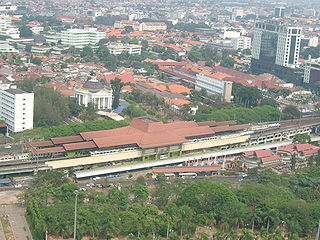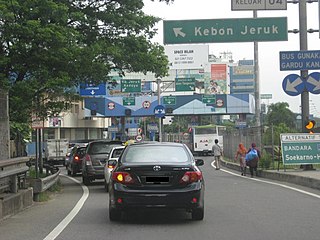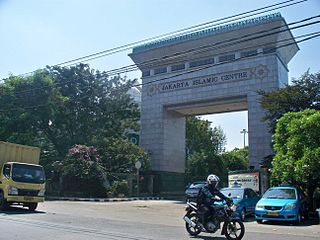Related Research Articles

North Jakarta is one of the five administrative cities which form Special Capital Region of Jakarta, Indonesia. North Jakarta is not self-governed and does not have a city council, hence it is not classified as a proper municipality. It contains the entire coastal area within the Jakarta Special Capital Region. North Jakarta, along with South Jakarta is the only two cities in Jakarta to border Banten and West Java. It is also the only city of Jakarta with a coastline and thus not landlocked. North Jakarta, an area at the estuary of Ciliwung river was the main port for the kingdom of Tarumanegara, which later grew to become Jakarta. Many historic sites and artefacts of Jakarta can be found in North Jakarta. Both ports of Tanjung Priok and historic Sunda Kelapa are located in the city. The city, which covers an area of 139.99 km2, had 1,645,659 inhabitants at the 2010 census and 1,778,981 at the 2020 census; the official estimate as at mid 2023 was 1,801,963. It has its administrative centre in Tanjung Priok.

Gambir is a district in the administrative city of Central Jakarta, Indonesia.. It is characterized by many historic buildings from the colonial era. It hosts some of the foremost political and learning/tourism features of the capital. The Merdeka Palace, the National Museum, the headquarters of the Indonesian Scout Movement and the Merdeka Square are among these.
Cempaka Putih is a district in the administrative city of Central Jakarta. Cempaka Putih is bounded by Jenderal Ahmad Yani Bypass Highway to the east, Pramuka Road to the south, Letjend Suprapto Road to the north, and a railway line to the west. The name "Cempaka Putih" is derived from flowering plant white champaca.

Johar Baru is a district in the administrative city of Central Jakarta, Indonesia. It is roughly bounded by Kampung Rawa Selatan Raya road and Mardani Raya road to the east, Percetakan Negara Raya Road to the south, Letjend Suprapto Road to the north, and a railway line to the west.

Senen is a long-established urban district of Central Jakarta, Indonesia that has kept many tourist attractions such as two museums, the National Library of Indonesia, Gelanggang Remaja Senen, and narrow alleys with old Chinese and similar style shops and restaurants. It was first developed in the 18th century as Pasar Senen when Governor Daendels established the bovenstad as the new center of government of the fledgling city. Its core remains in what is now the lower-division Senen Ditrict, Kwitang, Kenari, Paseban, Kramat, and Bungur. Senen is bounded by a railway line to the east, Ciliwung River to the west, Pramuka Street to the south, and Abdul Rahman Saleh-Kwini II-Senen Raya IV Street to the north. The name is derived from Pasar Senen,.

Kebon Jeruk is a district (kecamatan) of West Jakarta Administrative City, Indonesia. Kebon Jeruk is roughly bounded by Kali Pesanggrahan creek to the west, Kebayoran Lama Road to the south, Daan Mogot Road to the north, and Rawa Belong - Batu Sari Road to the east. The area is approximately 17.54 square km, and the official estimate of population as at mid 2023 was 370,282.

Palmerah is a district (kecamatan) of West Jakarta Administrative City, Indonesia. The district is roughly bounded by Jakarta-Merak Tollway to the north, Batusari - Rawa Belong Road to the west, Palmerah Barat - Palmerah Utara Road to the south, and Aipda K. Sasuit Tubun Road - Western Flood Canal to the east.

Tambora is a district (kecamatan) of West Jakarta Administrative City, Indonesia. Tambora District is bounded by a railway to the west and to the north, Kali Krukut - Kali Besar canal to the east, and Duri Selatan Road to the south.
Makasar is a district (kecamatan) of East Jakarta, Indonesia. It had an area of 21.85 km2 and population of 185,830 at the 2010 Census; the latest official estimate is 204,595.

South Tangerang is a city in the province of Banten, Indonesia. Located 30 km (19 mi) on the southwestern border of Jakarta, the city forms part of the Greater Jakarta metropolitan area. It was administratively separated from Tangerang Regency on 26 November 2008. According to the 2020 Census, the city population was 1,354,350 inhabitants, while the official estimate as at mid 2023 was 1,404,785 - comprising 700,754 males and 704,031 females. The total area is 164.85 km2 (63.65 sq mi). It is the second-largest city in Banten in terms of population, and has grown rapidly, not only as Jakarta's satellite city, but also the development of business districts and commerce due to presence of large-scale planned town by private developers.
North Rawa Badak is administrative village at Koja subdistrict, North Jakarta. The border of Rawa Badak Utara are :
South Rawa Badak is administrative village at Koja subdistrict, North Jakarta.

Jakarta Islamic Centre (JIC) is a center for Islamic studies and research in Koja, Jakarta, Indonesia. Activities of JIC include ZISWAF empowerment, education, socio-economic activities, regular recitations, Tabligh Akbar, and celebrations of Islamic holidays.
Sunter is a neighborhood in North Jakarta, Indonesia. The neighborhood corresponds roughly with the Sunter Agung and Sunter Jaya administrative village of Tanjung Priok subdistrict of North Jakarta. Zip code of the area is 14350. The area is adjacent to Plumpang Semper in the north, Kemayoran in the west, Kelapa Gading in the east and Cempaka Mas in the south. The area probably named after Sunter River, which flows through the neighborhood. The area is a low terrain and prone to flooding during heavy rain.

The Buaran River is a river flowing in the Bekasi, West Java, and the eastern part of the Special Capital Region of Jakarta, Indonesia. The lower portions of the original river have been channelized and directed into the eastern flood canal, "Banjir Kanal Timur", which continues to flow to the Java Sea in the district of Marunda, Cilincing, North Jakarta. The river regularly causes flooding in the cities of Bekasi and Jakarta.

Kampung Tugu is a historical neighborhood located in the northwestern Jakarta in the island of Java. Kampung Tugu grew from the land granted by the government of the Dutch East Indies to the converted Mardijker people in the 17th century. From this land, a Christian settlement grew and developed its own culture. Kampung Tugu is one of the oldest Christian neighborhoods in the western part of Indonesia. Today, the Christian neighborhood of Kampung Tugu is part of the Administrative Village of Tugu in Koja Subdistrict of North Jakarta, Indonesia.

The Cililitan-Tanjung Priok Road, also known as the Jakarta Bypass or simply Bypass, is a 27 km long bypass road in Jakarta, Indonesia that connects the Dewi Sartika Road and the Bogor Main Road in Cililitan, East Jakarta to the Port of Tanjung Priok in North Jakarta. The road is divided into four parts: Jalan Mayjen Sutoyo Road, Jalan D.I. Panjaitan, Jalan Jend. Ahmad Yani Road, and Jalan Laksamana Yos Sudarso. The bypass was inaugurated by the first President of Indonesia, Sukarno on October 21, 1963. One of the Jakarta Inner Ring Road sections is built over the road.
References
- ↑ Indonesian Terminal Petikemas Koja
- ↑ Müller, K.; Pickell, D. (1997). East of Bali: From Lombok to Timor. Periplus. p. 217. ISBN 9789625931784 . Retrieved 2 March 2015.
- ↑ "Londoh » Zoek". Archived from the original on 2011-07-26.
- ↑ "KAMPUNG-TUGU". Archived from the original on 2010-02-13.
- ↑ Hanna Fransisca (1 January 2013). Dari Singkawang Ke Sampit: Kumpulan Puisi Esai. Cerah Budaya Indonesia. pp. 92–. GGKEY:HP3520KR1L4.
- 1 2 3 Elizabeth Pisani (4 November 2010). The Wisdom Of Whores: Bureaucrats, Brothels And The Business Of Aids. Granta Publications. pp. 45–. ISBN 978-1-84708-405-7.
- ↑ Law: SK Gubernur KDKI Jakarta No. 495/1998
- ↑ Law: SK Gubernur KDKI Jakarta No. 6485/1998
- 1 2 Louis (March 23, 2010). "Hitam Menjadi Putih". Wisata Pesisir. Wisata Pesisir.com. Archived from the original on March 27, 2010. Retrieved March 25, 2010.
- 1 2 "Kramat Tunggak, Dulu Lokalisasi Pelacuran Kini Pusat Keagamaan (Indonesian)". Fajar Online. February 18, 2010. Archived from the original on February 19, 2010. Retrieved March 25, 2010.